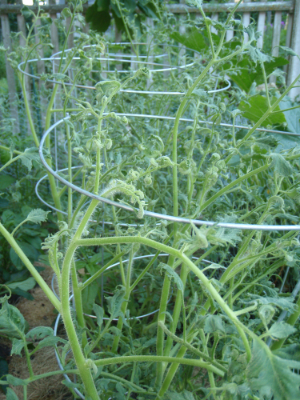Herbicide Drift

One of the most common questions during the summer months, especially if it is a hot dry summer is “Why are my (insert plant) leaves all twisted and curled?” Herbicide drift injury happens far too often with the saddest part being that this issue is usually preventable and, in some cases, not caused by the homeowner. Unfortunately, many of our bedding and vegetable plants are very sensitive to herbicides and it doesn’t take much to cause the damage as shown on the left.
Herbicide drift can be caused by a variety of factors including temperature, wind speed and improper spraying practices. It’s best to spray when wind speeds are below 10 mph but not completely still (no air flow can actually make things worse) and when the temperature is below 80 degrees. Several common lawn and weed killer products contain 2,4-D which can volatilize at warm temperatures before it dries and spread to where we don’t want it. Always check the weather and read the label prior to applying any chemical to ensure you are using it safely.
Luckily unless a tree or shrub is already stressed or get a large does of herbicide most trees and shrubs will survive some herbicide drift. Annuals and other herbaceous plants on the other hand can easily be killed or severely stunted by drift. Once a vegetable has been hit with a herbicide it’s ultimately up to the homeowner of if they want to eat the produce. There is not much information on how much chemical moves into the fruit from the leaves. It’s best to prevent drift when possible and replant if you can.

